Preying for Power in Lyari
By Zehra Nabi | News & Politics | Published 13 years ago
On May 2, 10-year-old Hammad was struck by a stray bullet and then crushed to death under the monstrous wheels of an armed personnel carrier.
It was the 6th day of the now infamous Lyari operation and Hammad was on his way home from the madrassah where he was studying to be a Hafiz-e-Quran. According to bystanders, he saw people protesting against the operation on the streets and walked closer to get a better look at them. The police allegedly began firing at the crowd blindly, which is when Hammad was shot.
“Was Hammad a gangster?” asked his mother. “Is the police blind that they did not see children standing before them?” Hammad’s family lives in a small, decrepit house in the narrow, meandering alleyways of Lyari. His family showed Newsline a graphic photograph of Hammad from an Urdu daily, in which you could see how his head was disfigured by the weight of the carrier. Only two years ago, a stray bullet killed his older brother, Junaid.
“First I used to cry for Junaid and it was Hammad who helped lessen my grief. But today I cry for both of them” she said, holding back tears.
Hammad’s aunt described how the neighbourhood children live in constant fear of future operations: “They keep asking ‘Will what happened to Hammad happen to us next?’” She added, “The Rangers had their operations in Lyari in the past and they would go door-to-door interrogating people. But we’ve never experienced this kind of terror before.”
While the family members silently wiped away tears, Hammad’s mother held herself together. “Just let Chaudhry Aslam come in front of me once and see what I do to him. If he can have children killed, then he can go ahead and kill us mothers too.”
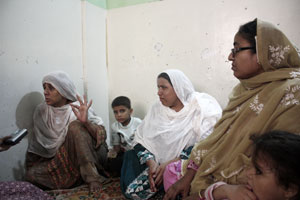
Hammad’s family relates how the young boy died.
The family hopes Chief Justice Iftikhar Chaudhry will take some action against the culprits behind Hammad’s death but they are aware that nothing will be done in the end. They say that they can only pray for CID SSP Chaudhry Aslam and Interior Minister Rehman Malik, who they dub ‘Zaalim Malik,’ to suffer as terribly as the people of Lyari are suffering right now.
Immediately after the operation, Sindh Chief Minister Qaim Ali Shah had stated that Rs 500,000 would be provided to the families of those who died. Hammad’s family hasn’t even been offered condolences by the government, let alone monetary compensation.
Ghulam Dastagir’s family hasn’t yet received anything from the government either. Dastagir was an FIA officer who got caught in the middle of crossfire near his home in Kalakot on the first day of the operation. He was shot in the head and it was with great difficulty in the midst of firing that his son dragged his father’s body out of the street and eventually found an ambulance. But by the time they reached the hospital it was too late and Dastagir had already passed away. He is survived by six children, of whom the youngest, 12-year-old Saba, fainted upon seeing her father’s corpse. His son Aqil compared the eight days of the operation to living in a warzone since the government had shut down electricity, gas and water.
“We had nothing. We couldn’t step out of the house. We had to make the food lying in the house last 10 days,” Aqil said, “and we have no hope that justice will ever be served. People here will just go on chanting ‘Jeay Bhutto.’”
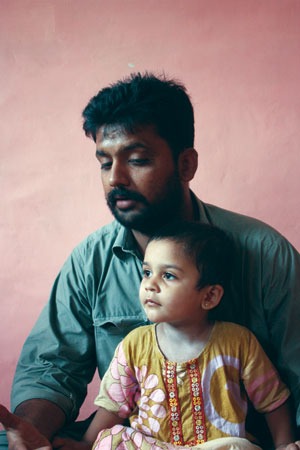
FIA officer Ghulam Dastagir was was killed during the operation but his son has little hope that justice will be served.
Although Dastagir’s family is Sindhi, his son believes that the only person who may be able to bring some change to Lyari is Uzair Baloch,leader of the banned People’s Amn Committee (PAC), against whom the operation was launched in the first place.
Originally intended to clip the wings of the Amn Committee and the various criminal elements operating in Lyari, the operation was hastily suspended by Rehman Malik after eight long days of violence. SSP CID Mohammed Aslam Khan, commonly known as Chaudhry Aslam, headed the operation, which proved to be a source of embarrassment for the government since the forces were unable to move beyond Cheel Chowk, a landmark in Lyari.
Chaudhry Aslam deployed more than 1,400 men from the police and the Frontier Constabulatory (FC), who reportedly used Rs 5 million worth of bullets during the operation. However, the police was left battered by the combatants in what turned out to be eight days of urban guerrilla warfare. While the residents of Lyari are fuming at the CID and the government for launching the operation, bullets certainly flew from both sides. Nearly all of the police’s armoured personnel carriers (APC), which cost approximately Rs 10 million each, were destroyed. According to some accounts the police was blindly firing at everyone. According to others, they were only shooting in the air while militants fired rocket launchers at them. Six days into the operation, reinforcements in the form of four APCS, 100 sharpshooters and 25 snipers were called in. The police also had its share of casualties during the operation, with Constable Fayyaz Ahmed and SHO Fawad Khan among the slain.
On the one hand it is nearly impossible to justify the operation, which subjected more than a million people to eight days of tyranny. On the other, the outlawed People’s Amn Committee (PAC) is said to be running a vast bhatta mafia and working closely with gangsters such as Noor Muhammad, alias Baba Ladla. Uzair Baloch vehemently denies any relationship with the notorious criminal (see interview) even though he has previously said on television that Baba Ladla is like a brother to him. Such contradictory statements are not unusual when it comes to the controversial Amn Committee. After all, Zulfikar Mirza too once denied links with the Committee and it wasn’t until 2011 that he began calling them the PPP’s soldiers in public.
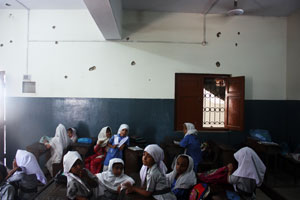
A bullet-riddled classroom in Lyari.
PPP MNA Nabeel Gabol believes that the PAC is behind the murder of his right-hand man Malik Mohammad Khan, who along with a police officer was shot dead on April 26. On the surface it does appear that the operation was launched to avenge such acts of violence that have become commonplace in the city. Uzair Baloch, however, asserts that Owais Muzaffar Tappi, Zardari’s half-brother and allegedly the de facto chief minister of Sindh, instigated the operation on a personal vendetta against Baloch for turning against the PPP. And then there are some who believe that that the government ordered this operation to appease coalition partner MQM, who accuse the PAC of target killings and extortion — a rather hypocritical, but still valid, accusation.
But for whatever reason it was launched, the operation was a failure. Why did the police bring in massive APCs that were difficult to navigate through the narrow lanes? Were the policemen briefed on how to protect civilians caught in the crossfire? What was the government thinking when it cracked down on the entire town just to capture a handful of men?
You certainly won’t get any answers from Chaudhry Aslam since he told Newsline that he has been ordered ‘from above’ not to talk about the operation. On the last day of the operation, lawyer Salahuddin Khan Gandapur filed a petition against the operation and the Sindh High Court bench issued notices to Chaudhry Aslam, as well as some of the senior ranking officers of the Sindh police. Many political parties have condemned the operation, including JSQM, the Balochistan National Party (BNP), ANP and, of course, the PML-N, who have lately been trying to angle themselves closer to Uzair Baloch.
On May 4, PML-N Sindh President Ghous Ali Shah formally invited Uzair Baloch to join the party and later on May 22, Marvi Memon represented the party at the Mohabbat-e-Sindh rally, which had turned bloody when unknown men shot at the protestors from the rooftops in Pan Mandi.
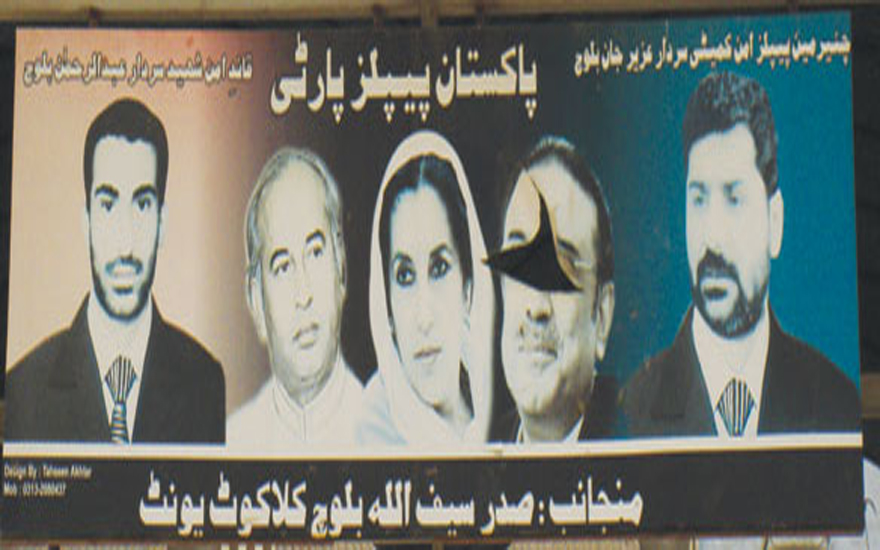
A banner at the Gabol football ground in Lyari.
The PML-N wouldn’t even have dreamt of reaching out to the Amn Committee had the PPP’s constituency not been in danger of being swayed to a different side. The town has historically been a PPP stronghold but visit it today and you will see more posters of Uzair Baloch and the deceased Rehman Dakait than those of Benazir Bhutto and Zulfikar Ali Bhutto. President Zardari, on the other hand, would be lucky to find a single poster of himself that hasn’t been vandalised.
The PPP wasn’t always the major stakeholder in Lyari. For nearly 30 years, the Haroon family, who are from the Kutchi Memon community, exercised power in Lyari. Haji Abdullah Haroon made it big in the sugar industry and went on to provide basic educational and welfare services to the Lyariites. When the PPP was created, Zulfikar Ali Bhutto travelled to Lyari where he sat and ate with the people, promising more reforms and resources. Elderly Lyariites recall how he would remember people’s names even if he were meeting them after months, a quality that Benazir tried to emulate and one that today is embodied by Uzair Baloch, rather than Bilawal or Zardari. Bhutto’s popularity eclipsed that of the Haroons and, to his credit, he provided the people with a sewerage system, water supply and the Lyari General Hospital, which is today in shambles.
Since then the party has done little, but the Lyariites have continued to support the PPP.
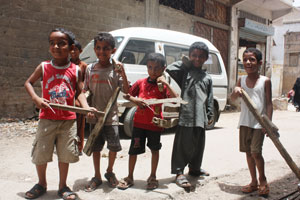
Children use sticks as make-shift guns when playing on the streets
“People here are simple. They will be grateful to you for life if you even offer them half a glass of water. Zulfikar Bhutto came and leased lands for us, which is why the PPP enjoyed such popularity here for decades,” explained Ghulam Dastagir’s son.
Benazir Bhutto had kept the fervour alive in Lyari. But the present-day PPP is only a source of disillusionment for the Lyari residents.
“Nobody wants to take ownership of Lyari. Everything is a tamasha. Just take a look at the schools,” stated Habib Hassan, chairman of the Lyari District Centre. According to Hassan, the private schools, which charge tuition fees of 200-350 rupees, are too expensive for the average Lyariite whereas the government schools are prone to corruption and mismanagement. “The officers will say there are 200 students, even if only a fraction of the number exists, and once they get the budget from the government, the money goes straight into their pockets.”
The meagre educational opportunities, specially for boys, mean that young men are more likely to engage in criminal activities, thereby causing crime rates to rise.
So who is to blame for Lyari’s problems? The government points fingers at the criminals and states that the gang wars are the root of the violence and menace. But the people of Lyari think otherwise.
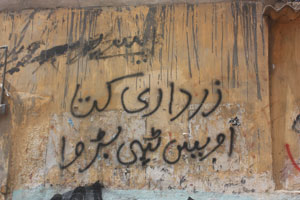
The writing on the wall.
“You go to (PPP MPA) Rafique Engineer to register your complaints and he’ll just wave at you from his car, saying he’ll look into them. Sardar Uzair Baloch, however, listens to all your problems and will even walk you to the gate,” added Mudassar, a young man who lives near Cheel Chowk and has been struggling to find a steady job since 2002.
It is a little too convenient for the government and the political parties to single out the gangs for the troubles in Lyari. After all, these very political parties sought alliances with gangsters and armed them with weapons so that they would fight their political battles for them. The crime, poverty and violence in Lyari all essentially boil down to one thing: political power play.
“There is no gang war here. It’s all political,” decrees Zafar Baloch, spokesperson of the PAC.
Zafar Baloch would deny the existence of gang wars but this very point is also reiterated by the schoolteachers at M.A Alvi Girls Public School. When the school finally reopened after the operation, the teachers found nearly 600 bullet shells on the grounds and the classrooms were riddled with bullet holes. The teachers believe that the police was using the school as a refuge during the operation, since it is located near Cheel Chowk, and they described how all the locks had been broken and the police had allegedly littered the classrooms with empty lunchboxes.
At the Gabol football ground, Newsline met a few Lyariites who described their disillusionment with the PPP government.
“They say there are gang wars going on here,” said a young man who works in the fisheries, “but are the Baloch behind all the problems of Karachi? What did we do to deserve this operation?”
The young men are extremely critical of the MQM, who supported the operation, and believe that MQM workers, along with Arshad Pappu’s thugs, were helping the police during the operation.
The MQM has tried to extend its influence into Lyari and it is a known secret that they support Arshad Pappu’s gang, who are not only sworn enemies of the PAC but who also killed Uzair Baloch’s father in 2003. To counter the MQM-supported Arshad Pappu gang, the PPP gave arms to the Amn Committee — an organisation that was originally intended to reform the image of the gangs and supposedly restore peace in Lyari.
The establishment is also a clandestine player in this ongoing turf war. This can be gathered from Uzair Baloch’s statements that he will only surrender to the Rangers and that he wants the army to take control of the city — a surprising request considering that in Balochistan the people want to be freed from the hold of the establishment.
The gangs are certainly armed and engaged in unlawful activities. But the political parties are the real criminals. Much like vultures, their existence depends on the weak and the wounded. It is in their interest for Lyari to stay impoverished, so that they can continue to exploit it as they please. As soon as one party steps back, another swoops in to try to position itself in power. And all this time the people of Lyari can do little except wait for this cycle of misery to end.
This article was originally published in the June issue of Newsline under the headline “Preying for Power.”
Zehra Nabi is a graduate student in The Writing Seminars at the Johns Hopkins University. She previously worked at Newsline and The Express Tribune.


